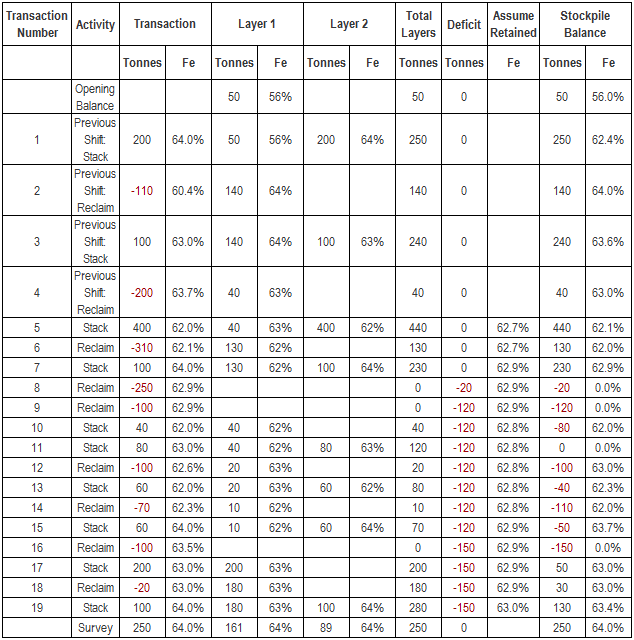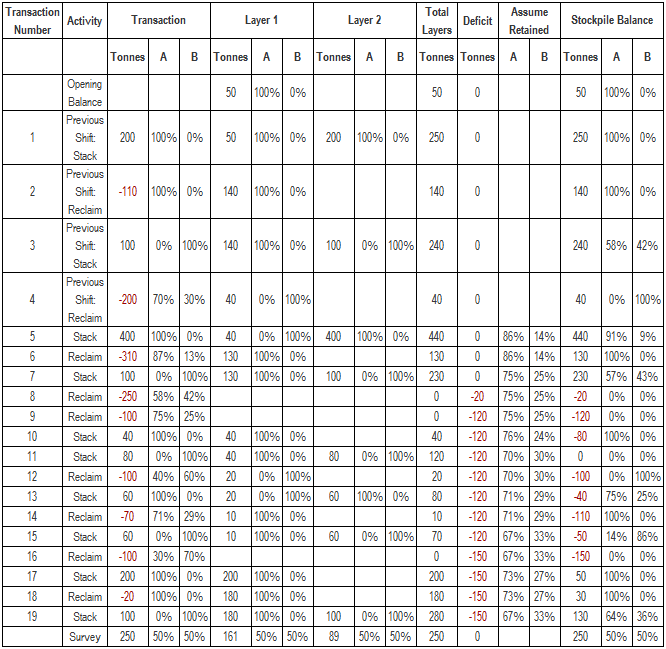Negative FIFO/LIFO Stockpile Example: Previous Period WAG
Calculations
The following scenarios describe the calculations on FIFO and LIFO stockpiles that go negative, assuming that the Negative Method is Previous Period WAG.
Reclaiming more material than is available in the layers
The first time more material is reclaimed than is available in the stockpile:
The layers are depleted first.
- A WAG Balance Deficit is created.
- The WAG Balance Deficit has a negative mass.
- The Assume Retained analytes and contributors on the WAG Balance Deficit are calculated as the weighted average of the analyte quality and contributors from the stacking transactions in the configured previous period.
- The stockpile balance equals the WAG Balance Deficit mass.
- The material reclaimed from the layers is assigned analyte quality and contributor values from the layers. The excess material is assigned Assume Retained analyte quality and contributor values.
- The analyte and contributor relevance (displayed in tooltips on the Activity and Contributor tabs on the Stockpile screen) reflect that some material is estimated by a model.
Subsequent reclaim transactions if there are no layers
If additional material is reclaimed:
- The reclaimed material is assigned Assume Retained analyte quality and contributor values.
- The stockpile WAG Balance Deficit is increased by the amount of reclaimed material.
- The stockpile balance equals the WAG Balance Deficit mass.
Subsequent stacking transactions
If material is subsequently stacked onto the stockpile:
- The stacked material creates a layer (for a single transaction) or layers (for multiple transactions).
- The stacked material retains its analyte quality and contributor values.
- The WAG Balance Deficit is not adjusted.
- The Assume Retained analytes and contributors on the WAG Balance Deficit are recalculated as the weighted average of the analyte quality and contributors from the stacking transactions in the configured previous period.
- The stockpile balance equals the quantity in the layers plus the WAG Balance Deficit mass.
Subsequent reclaim transactions if there are layers
If material is subsequently reclaimed from the stockpile:
- The material is reclaimed first from the layers.
- If the reclaimed mass is greater than the available layers, the WAG Balance Deficit is increased by the difference.
- The material reclaimed from the layers is assigned analyte quality and contributor values from the layers. The excess material is assigned Assume Retained analyte quality and contributor values.
- The stockpile balance equals the quantity in the layers plus the WAG Balance Deficit mass.
Stockpile survey
If the stockpile has a WAG Balance Deficit and no layers; and the survey includes a mass:
- The WAG Balance Deficit is reset to zero.
- A layer is created:
- The layer's mass comes from the survey.
- The layer's analyte quality and contributor values come from the calculated Assume Retained values.
If the stockpile has a WAG Balance Deficit and has a layer or layers; and the survey does not include a mass:
- The WAG Balance Deficit is retained.
- The mass of the layer(s) is not adjusted.
- The analyte quality and contributor values of the layer(s) are overwritten with any values provided in the survey.
If the stockpile has a WAG Balance Deficit and has a layer or layers; and the survey includes a mass:
- The WAG Balance Deficit is reset to zero.
- The layers are proportionately adjusted so that the total mass of the layers equals the mass of the survey.
- The analyte quality and contributor values of the layer(s) are overwritten with any values provided in the survey.
Analytes Example
The following table displays the effect on retained analyte quality from transactions on a FIFO stockpile. The configured Negative Method is Previous Period WAG, and the Date Option is Start Of Previous Shift.
Note: The calculations are similar for LIFO stockpiles. The difference is the order of the layers from which material is reclaimed. For FIFO stockpiles, material is reclaimed from Layer 1 first, if available. For LIFO stockpiles, material is reclaimed from the highest available layer first.

The calculation of Assume Retained analyte quality starts with Transaction 5, which is the first transaction of the current shift. There were three stacking transactions in the configured previous period (1, 3 and 5), and the weighted average analyte quality is calculated:
( 200 * 64% + 100 * 63% + 400 * 62% ) / ( 200 + 100 + 400 ) = 439 / 700 = 62.7%
Transaction 8 is the first transaction that makes the FIFO stockpile go negative. As a result:
- 230 t comes from the layers.
- A WAG Balance Deficit of –20 t is created.
- The stockpile balance is –20 t.
- The analyte quality of Transaction 8 is calculated:
( 130 * 62% + 100 * 64% + 20 * 62.9% ) / ( 130 + 100 + 20 ) = 157.2 / 250 = 62.9%
Transaction 9 reclaims 100 t from the stockpile when there are no layers. As a result:
- The WAG Balance Deficit is increased to –120 t.
- The stockpile balance is –120 t.
- The analyte quality of Transaction 8 is the Assume Retained analyte quality; that is, 62.9%.
Transaction 10 stacks 40 t of material with an analyte quality of 62% onto the stockpile. As a result:
- One layer of 40 t is created with an analyte quality of 62%.
- The WAG Balance Deficit stays at –120 t.
- The stockpile balance is calculated:
–120 + 40 = –80
- The Assume Retained analyte quality is calculated as the weighted average of Transactions 1, 3, 5, 7 and 10.
Transaction 11 stacks 80 t of material onto the stockpile. As a result:
- The stockpile balance returns to 0 t.
- Because the stockpile balance is 0 t, the analyte values are reset to 0%.
Transaction 12 reclaims 100 t from the stockpile when there are layers. As a result:
- 40 t comes from Layer 1 and 60 t comes from Layer 2.
- The WAG Balance Deficit stays at –120 t.
- The stockpile balance is calculated:
–120 + 20 = –100
- The analyte quality of Transaction 12 is calculated:
( 40 * 62% + 60 * 63% ) / ( 40 + 60 ) = 62.6 / 100 = 62.6%
A survey takes place after Transaction 19, when the stockpile has two layers. The survey includes a mass of 250 t and an analyte quality of 64%. As a result:
- The WAG Balance Deficit is reset to zero.
- The masses of the two layers are adjusted proportionally so that their total is 250 t. The multiplication factor is:
250 / ( 180 + 100 ) = 250 / 280 = 0.893
- The analyte quality from the survey is assigned to both layers.
Contributors Example
The following table displays the effect on retained contributor values from transactions on a FIFO stockpile. The configured Negative Method is Previous Period WAG, and the Date Option is Start Of Previous Shift.
Note: The calculations are similar for LIFO stockpiles. The difference is the order of the layers from which material is reclaimed. For FIFO stockpiles, material is reclaimed from Layer 1 first, if available. For LIFO stockpiles, material is reclaimed from the highest available layer first.

The calculation of Assume Retained contributor values starts with Transaction 5, which is the first transaction of the current shift. There were three stacking transactions in the configured previous period (1, 3 and 5), and the contributor values are calculated as a weighted average of the stacking transactions. For example, the value for Contributor A is calculated:
( 200 * 100% +100 * 0% + 400 * 100% ) / ( 200 + 100 + 400 ) = 600 / 700 = 86%
Transaction 8 is the first transaction that makes the FIFO stockpile go negative. As a result:
- 230 t comes from the layers.
- A WAG Balance Deficit of –20 t is created.
- The stockpile balance is –20 t.
- The contributor values are calculated as a weighted average of the two layers and the Assume Retained contributor value on the WAG Balance Deficit. For example, the value for Contributor A of Transaction 8 is calculated:
( 130 * 100% + 100 * 0% + 20 * 75% ) / ( 130 + 100 + 20 ) = 145 / 250 = 58%
Transaction 9 reclaims 100 t from the stockpile when there are no layers. As a result:
- The WAG Balance Deficit is increased to –120 t.
- The stockpile balance is –120 t.
- The contributor values are the Assume Retained contributor values; that is, 75% for A and 25% for B.
Transaction 10 stacks 40 t of material with contributor values of 100% for A and 0% for B onto the stockpile. As a result:
- One layer of 40 t is created with contributor values of 100% for A and 0% for B.
- The WAG Balance Deficit stays at –120 t.
- The stockpile balance is calculated:
–120 + 40 = –80
- The Assume Retained contributor values are calculated as the weighted average of Transactions 1, 3, 5, 7 and 10.
Transaction 11 stacks 80 t of material onto the stockpile. As a result:
- The stockpile balance returns to 0 t.
- Because the stockpile balance is 0 t, the contributor values are reset to 0%.
Transaction 12 reclaims 100 t from the stockpile when there are layers. As a result:
- 40 t comes from Layer 1 and 60 t comes from Layer 2.
- The WAG Balance Deficit stays at –120 t.
- The stockpile balance is calculated:
–120 + 20 = –100
- The contributor values of Transaction 12 are calculated as a weighted average of the layers. For example, the value for Contributor A of Transaction 12 is calculated:
( 40 * 100% + 60 * 0% ) / ( 40 + 60 ) = 40 / 100 = 40%
A survey takes place after Transaction 19, when the stockpile has two layers. The survey includes a mass of 250 t and contributor values of 50% for A and B. As a result:
- The WAG Balance Deficit is reset to zero.
- The masses of the two layers are adjusted proportionally so that their total is 250 t. The multiplication factor is:
250 / ( 180 + 100 ) = 250 / 280 = 0.893
- The contributor values from the survey are assigned to both layers.

